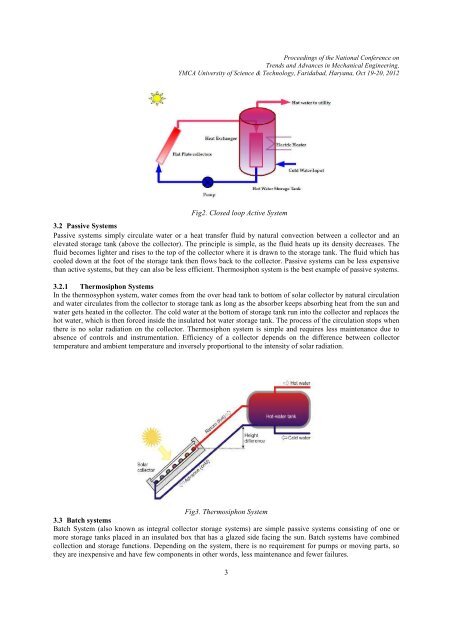study of solar water heaters based on exergy analysis - YMCA ...
study of solar water heaters based on exergy analysis - YMCA ...
study of solar water heaters based on exergy analysis - YMCA ...
You also want an ePaper? Increase the reach of your titles
YUMPU automatically turns print PDFs into web optimized ePapers that Google loves.
Proceedings <str<strong>on</strong>g>of</str<strong>on</strong>g> the Nati<strong>on</strong>al C<strong>on</strong>ference <strong>on</strong><br />
Trends and Advances in Mechanical Engineering,<br />
<strong>YMCA</strong> University <str<strong>on</strong>g>of</str<strong>on</strong>g> Science & Technology, Faridabad, Haryana, Oct 19-20, 2012<br />
Fig2. Closed loop Active System<br />
3.2 Passive Systems<br />
Passive systems simply circulate <str<strong>on</strong>g>water</str<strong>on</strong>g> or a heat transfer fluid by natural c<strong>on</strong>vecti<strong>on</strong> between a collector and an<br />
elevated storage tank (above the collector). The principle is simple, as the fluid heats up its density decreases. The<br />
fluid becomes lighter and rises to the top <str<strong>on</strong>g>of</str<strong>on</strong>g> the collector where it is drawn to the storage tank. The fluid which has<br />
cooled down at the foot <str<strong>on</strong>g>of</str<strong>on</strong>g> the storage tank then flows back to the collector. Passive systems can be less expensive<br />
than active systems, but they can also be less efficient. Thermosiph<strong>on</strong> system is the best example <str<strong>on</strong>g>of</str<strong>on</strong>g> passive systems.<br />
3.2.1 Thermosiph<strong>on</strong> Systems<br />
In the thermosyph<strong>on</strong> system, <str<strong>on</strong>g>water</str<strong>on</strong>g> comes from the over head tank to bottom <str<strong>on</strong>g>of</str<strong>on</strong>g> <str<strong>on</strong>g>solar</str<strong>on</strong>g> collector by natural circulati<strong>on</strong><br />
and <str<strong>on</strong>g>water</str<strong>on</strong>g> circulates from the collector to storage tank as l<strong>on</strong>g as the absorber keeps absorbing heat from the sun and<br />
<str<strong>on</strong>g>water</str<strong>on</strong>g> gets heated in the collector. The cold <str<strong>on</strong>g>water</str<strong>on</strong>g> at the bottom <str<strong>on</strong>g>of</str<strong>on</strong>g> storage tank run into the collector and replaces the<br />
hot <str<strong>on</strong>g>water</str<strong>on</strong>g>, which is then forced inside the insulated hot <str<strong>on</strong>g>water</str<strong>on</strong>g> storage tank. The process <str<strong>on</strong>g>of</str<strong>on</strong>g> the circulati<strong>on</strong> stops when<br />
there is no <str<strong>on</strong>g>solar</str<strong>on</strong>g> radiati<strong>on</strong> <strong>on</strong> the collector. Thermosiph<strong>on</strong> system is simple and requires less maintenance due to<br />
absence <str<strong>on</strong>g>of</str<strong>on</strong>g> c<strong>on</strong>trols and instrumentati<strong>on</strong>. Efficiency <str<strong>on</strong>g>of</str<strong>on</strong>g> a collector depends <strong>on</strong> the difference between collector<br />
temperature and ambient temperature and inversely proporti<strong>on</strong>al to the intensity <str<strong>on</strong>g>of</str<strong>on</strong>g> <str<strong>on</strong>g>solar</str<strong>on</strong>g> radiati<strong>on</strong>.<br />
Fig3. Thermosiph<strong>on</strong> System<br />
3.3 Batch systems<br />
Batch System (also known as integral collector storage systems) are simple passive systems c<strong>on</strong>sisting <str<strong>on</strong>g>of</str<strong>on</strong>g> <strong>on</strong>e or<br />
more storage tanks placed in an insulated box that has a glazed side facing the sun. Batch systems have combined<br />
collecti<strong>on</strong> and storage functi<strong>on</strong>s. Depending <strong>on</strong> the system, there is no requirement for pumps or moving parts, so<br />
they are inexpensive and have few comp<strong>on</strong>ents in other words, less maintenance and fewer failures.<br />
3













